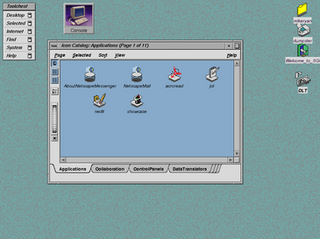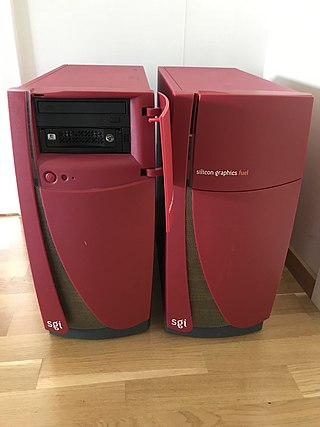Related Research Articles

The Common Desktop Environment (CDE) is a desktop environment for Unix and OpenVMS, based on the Motif widget toolkit. It was part of the UNIX 98 Workstation Product Standard, and was for a long time the Unix desktop associated with commercial Unix workstations. It helped to influence early implementations of successor projects such as KDE and GNOME, which largely replaced CDE following the turn of the century.

The history of the graphical user interface, understood as the use of graphic icons and a pointing device to control a computer, covers a five-decade span of incremental refinements, built on some constant core principles. Several vendors have created their own windowing systems based on independent code, but with basic elements in common that define the WIMP "window, icon, menu and pointing device" paradigm.

IRIX is a discontinued operating system developed by Silicon Graphics (SGI) to run on the company's proprietary MIPS workstations and servers. It is based on UNIX System V with BSD extensions. In IRIX, SGI originated the XFS file system and the industry-standard OpenGL graphics system.

Silicon Graphics, Inc. was an American high-performance computing manufacturer, producing computer hardware and software. Founded in Mountain View, California in November 1981 by James Clark, its initial market was 3D graphics computer workstations, but its products, strategies and market positions developed significantly over time.
XFS is a high-performance 64-bit journaling file system created by Silicon Graphics, Inc (SGI) in 1993. It was the default file system in SGI's IRIX operating system starting with its version 5.3. XFS was ported to the Linux kernel in 2001; as of June 2014, XFS is supported by most Linux distributions; Red Hat Enterprise Linux uses it as its default file system.

A workstation is a special computer designed for technical or scientific applications. Intended primarily to be used by a single user, they are commonly connected to a local area network and run multi-user operating systems. The term workstation has been used loosely to refer to everything from a mainframe computer terminal to a PC connected to a network, but the most common form refers to the class of hardware offered by several current and defunct companies such as Sun Microsystems, Silicon Graphics, Apollo Computer, DEC, HP, NeXT, and IBM which powered the 3D computer graphics revolution of the late 1990s.
4Dwm is the window manager component of the IRIX Interactive Desktop normally used on Silicon Graphics workstations running IRIX. 4Dwm is derived from the older Motif Window Manager and uses the Motif widget toolkit on top of the X Window System found on most Unix systems. 4Dwm on IRIX was one of the first default graphical user interface desktops to be standard on a Unix computer system. 4Dwm refers to "Fourth dimension window manager" and has no relation to dwm.
IRIS GL is a proprietary graphics API created by Silicon Graphics (SGI) in the early 1980s for producing 2D and 3D computer graphics on their IRIX-based IRIS graphical workstations. Later SGI removed their proprietary code, reworked various system calls, and released IRIS GL as the industry standard OpenGL.
The Indy, code-named "Guinness", is a low-end multimedia workstation introduced on July 12, 1993 by Silicon Graphics Incorporated (SGI). SGI developed, manufactured, and marketed Indy as the lowest end of its product line, for computer-aided design (CAD), desktop publishing, and multimedia markets. It competed with Intel x86 computers, and with Windows and Macintosh, including using their files and running their applications via software emulation. It is the first computer to come standard with a video camera, called IndyCam.

The SGI Fuel is a mid-range workstation developed and manufactured by Silicon Graphics, Inc. (SGI). It was introduced in January 2002, with a list price of US$11,495. Together with the entire MIPS platform, general availability for the Fuel ended on December 29, 2006. An equivalent product for the same market segment was not provided until 2008, when the Virtu product line was introduced, based on x86 microprocessors and Nvidia graphics.

The O2 is an entry-level Unix workstation introduced in 1996 by Silicon Graphics, Inc. (SGI) to replace their earlier Indy series. Like the Indy, the O2 uses a single MIPS microprocessor and was intended to be used mainly for multimedia. Its larger counterpart is the SGI Octane. The O2 was SGI's last attempt at a low-end workstation.
mex is a windowing system created by Silicon Graphics, used on 68k-based IRIS systems and early IRIS 4D systems. Mex was originally loaded over a network through the utilization of GL1 routines kept on a remote host machine, usually a VAX. When the IRIS 1400 workstation and GL2-W (IRIX) were introduced, mex was allowed to run locally. Mex was used in IRIX from the GL2-W2.1.0 release to the 4D1-2.3 release.
The Indigo, introduced as the IRIS Indigo, is a line of workstation computers developed and manufactured by Silicon Graphics, Inc. (SGI). SGI first announced the system in July 1991.

IRIX Interactive Desktop is a discontinued desktop environment normally used as the default desktop on Silicon Graphics workstations running IRIX. The IRIX Interactive Desktop uses the Motif widget toolkit on top of the X Window System found on most Unix systems. The default window manager on the IRIX Interactive Desktop is 4Dwm.

The IRIS Crimson is a Silicon Graphics (SGI) computer released in 1992. It is the world's first 64-bit workstation.
Core OpenGL, or CGL, is Apple Inc.'s Macintosh Quartz windowing system interface to the OS X implementation of the OpenGL specification. CGL is analogous to GLX, which is the X11 interface to OpenGL, as well as WGL, which is the Microsoft Windows interface to OpenGL.
Silicon Graphics Image (SGI) or the RGB file format is the native raster graphics file format for Silicon Graphics workstations. The format was invented by Paul Haeberli. It can be run-length encoded (RLE). FFmpeg and ImageMagick, among others, support this format.
Xsgi is the X Window System (X11) server for the IRIX-based graphical workstations and servers from Silicon Graphics (SGI). Xsgi was released in 1991 with IRIX 4.0 on the SGI Indigo workstation.

Dogfight is a demonstration program initially written by Gary Tarolli at Silicon Graphics, Inc in the summer of 1983. It represents landmarks in two key areas of Internet development: games and multicasting, and notable advancement in creating rendered virtual environments.
The SGI IRIS series of terminals and workstations from Silicon Graphics was produced in the 1980s and 1990s. IRIS is an acronym for Integrated Raster Imaging System.
References
- Jim Barton: Silicon Graphics Computer Systems USENET comp.sys.sgi, 4D1-3.2 1989 Release Notes (Part 1 of 3)